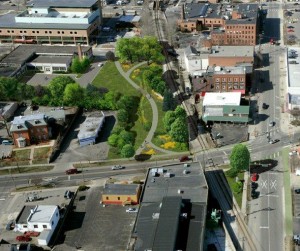
Several new redevelopment projects are moving forward in the City of Ann Arbor that should make river lovers happy.
The City has formed a new task force to develop a vision for connecting North Main Street and the Huron River. It’s first project is to create a plan for turning the old fleet services garage at 721 N. Main into a greenway park.
The task force will also address opportunities to enhance pedestrian and bicycle connections between downtown, Bandemer Park, and Huron River Drive, as well new uses for the riverside MichCon property off Broadway Street, where DTE Energy is undertaking a major cleanup project.
Other potential projects include creating a greenway over and around the currently underground Allen Creek along its historical creekbed through the west side of Ann Arbor.
Across town, the DEQ recently announced a $1 million brownfield redevelopment grant to help return the former Georgetown Mall in Ann Arbor to commercial use. The long-vacant mall will become a bicycle and pedestrian friendly center, with both shops and apartments, as well as a small park. The redevelopment will also feature new stormwater management controls and underground parking.
How do these activities help the Huron?
Here are the reasons why redevelopment, or infill, projects, and projects that create people-friendly amenities are good for the river:
1. Developments occurring on existing urban properties do not add impervious surfaces to our watershed. The river will not know the difference between the old Georgetown Mall site and the new mixed use development. In fact, it will enjoy improvements due to the new stormwater controls to accompany the new development.
2. These projects create opportunities for people to live and work within the city, a welcome improvement over the land-consuming low density pattern of development that has characterized residential and commercial growth in Michigan over the past decade. The best way to keep the river healthy is to create livable, compact communities that result in the least amount of impervious surface in the watershed, and to keep natural lands natural.
3. Creating greenways and connecting people to the great recreation and scenic resource the river provides brings people not only to the river (thus increasing their appreciation for and the importance of protecting the river), but also to the city, where they will be attracted to it as a place to live and work.



